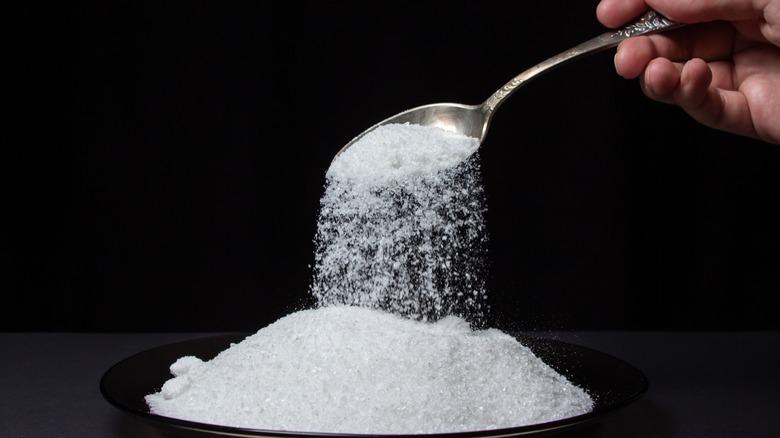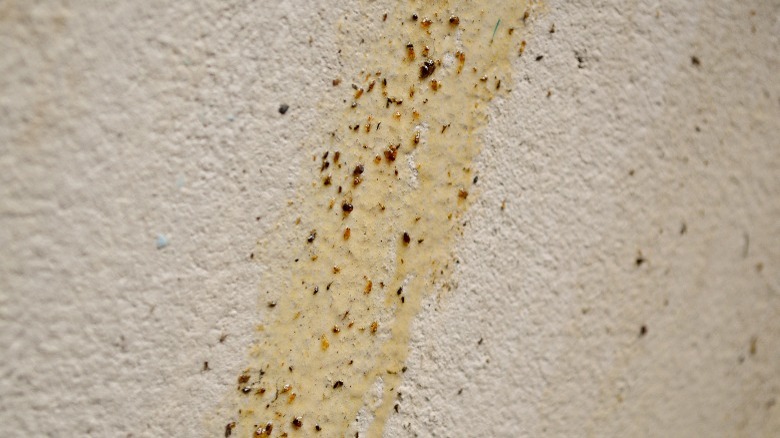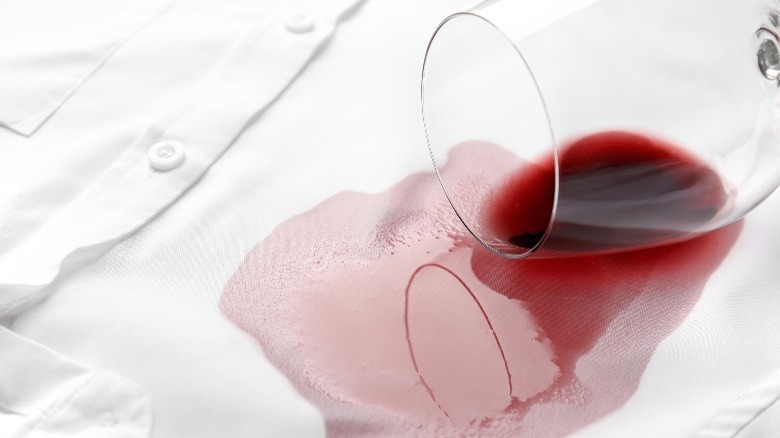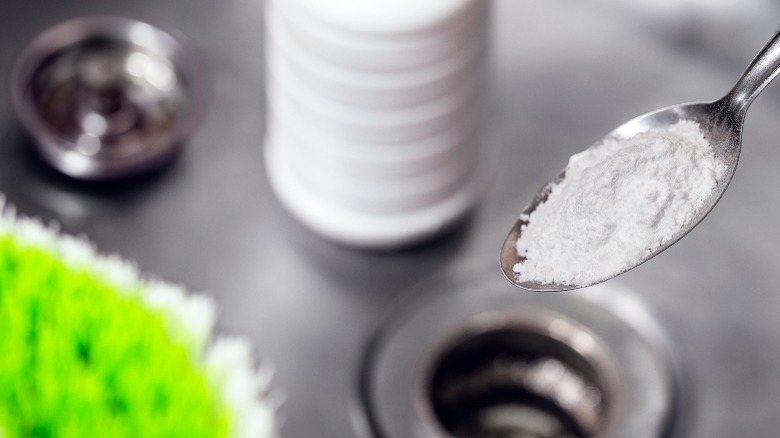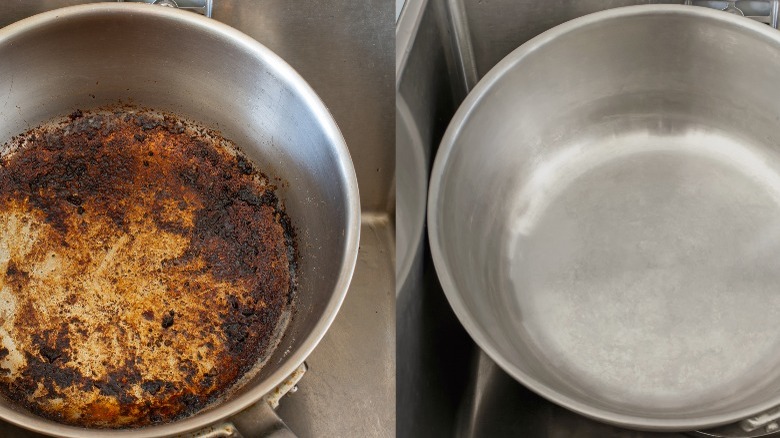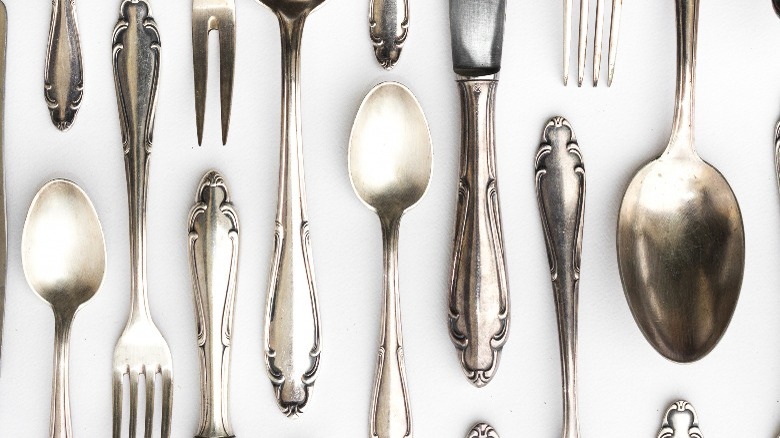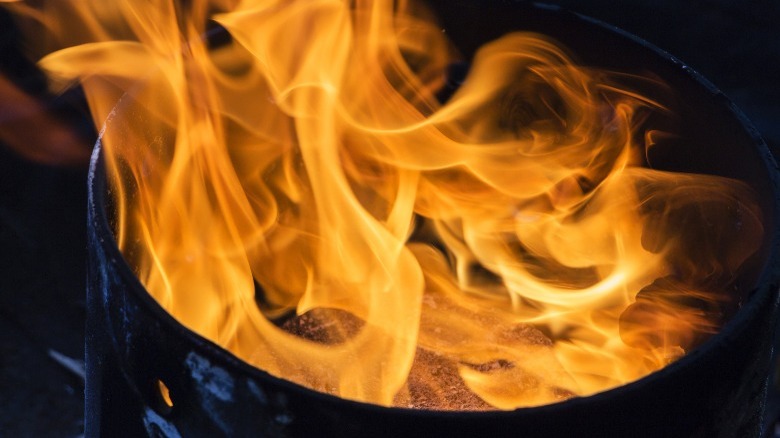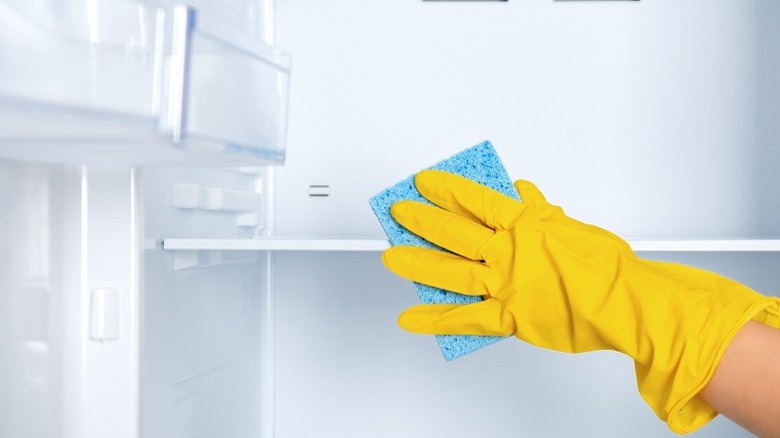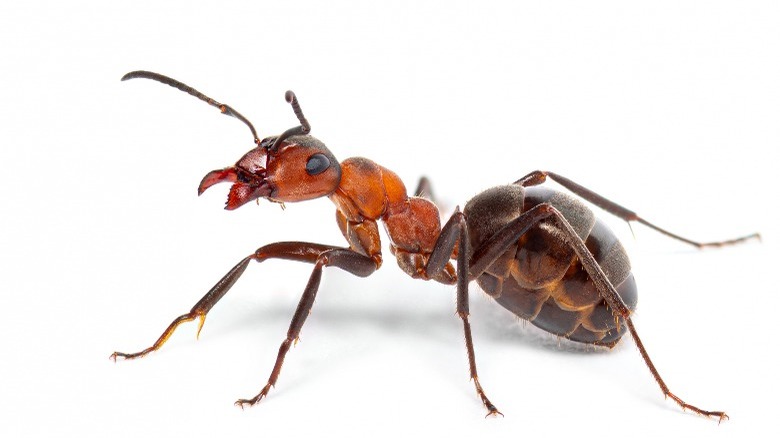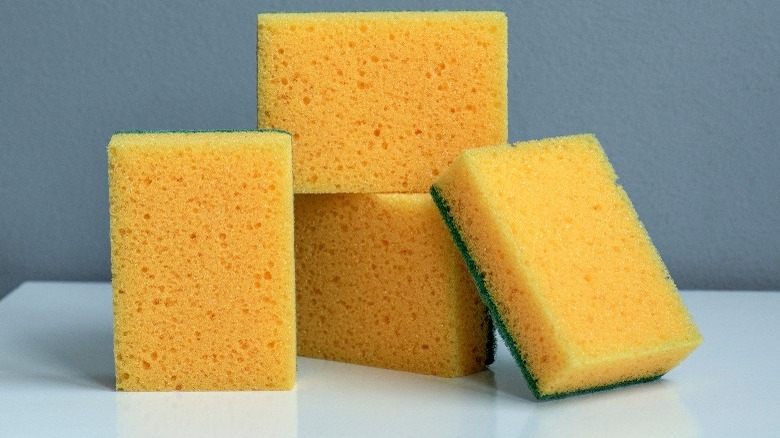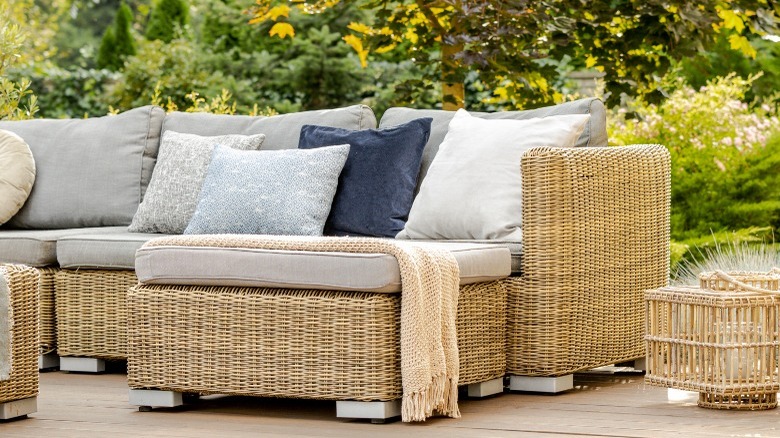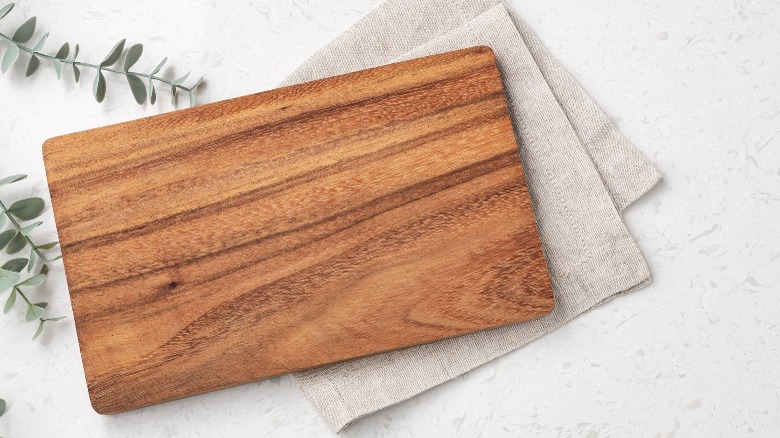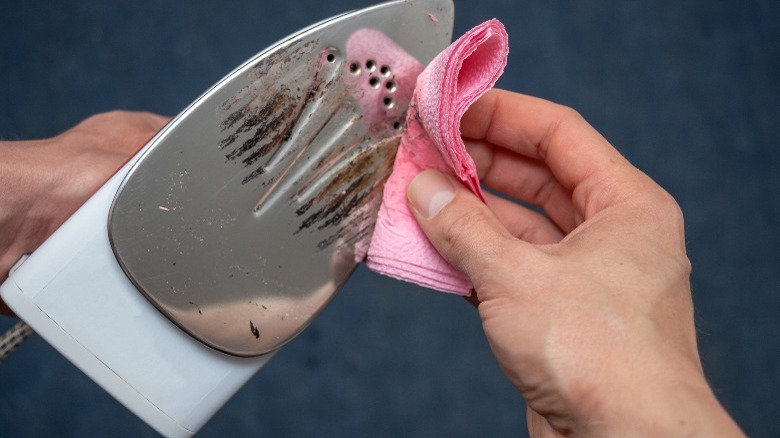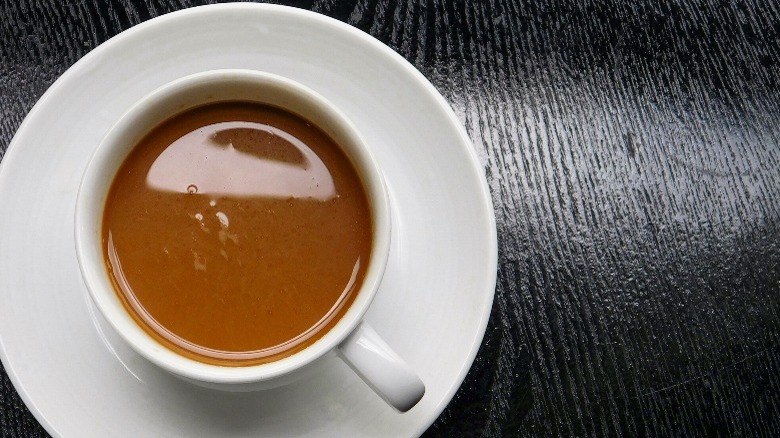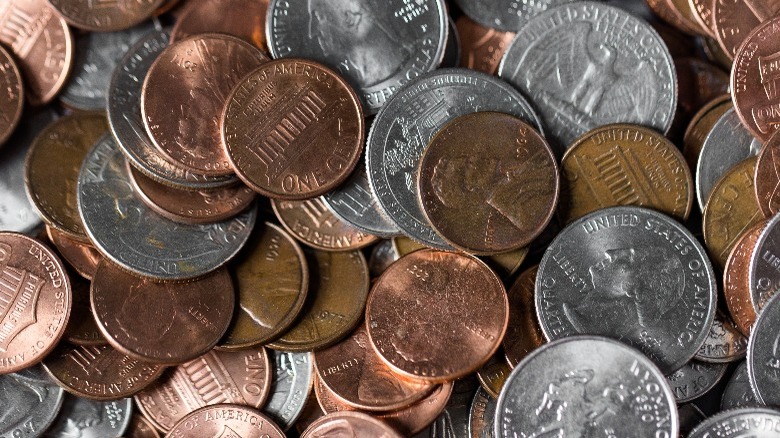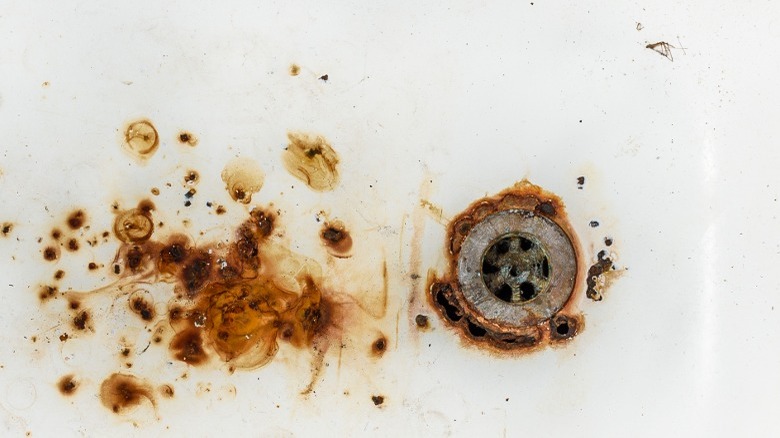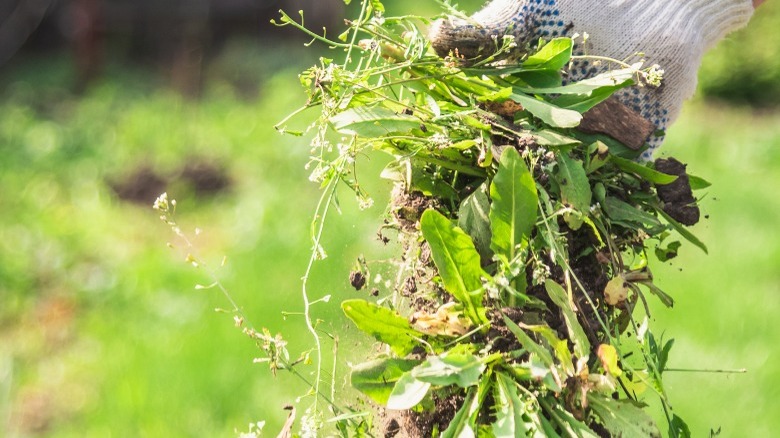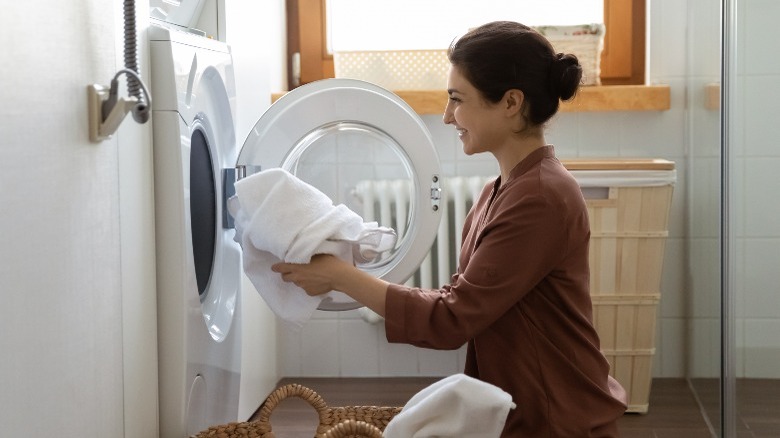Genius Ways To Use Salt Around The House
Salt is not a complicated mineral because it's only made up of two elements: sodium and chloride. And interestingly enough, that combination is good for a heck of a lot more than cooking. You needn't be a genius to use it outside of the kitchen, laundry, and other parts of the house. And not only that, salt works wonders in the garden.
Salt has a lower freezing temperature than ice, so homeowners use it to make the ground less slippery. Salt also has dehydrating properties that make it draw out moisture. This makes it helpful for cleaning spills. On top of all this, the salt crystals are abrasive enough to shine things up. It's always good to have plenty of extra table and coarse salt on hand to use around the house – unlike toxic household products, it's eco-friendly, inexpensive, and sometimes, even more effective. None of these methods require a lot of work, either.
Sprinkle it on oil spills
Oil spills can be a nightmare to clean up because a few spritzes of cleaner or a bit of dish soap won't do the job. There will be a sheen of oil left, so removing it usually requires several passes. And if it's not completely cleaned off, someone could slip and fall. Just pour enough regular table salt to cover the spill and let it sit for about 10 minutes. Wipe it up with a paper towel, and then clean the area with dish soap and paper towels. And test it for slipperiness before letting anyone walks on it.
This works because salt speeds up fatty acid oxidation in oils, causing them to break down. But it's not recommended for cleaning oil spills on concrete surfaces like driveways. Concrete is porous and absorbs sodium chloride so over time, it causes corrosion, cracks, and discoloration.
Clean up red wine stains
Red wine can be quite fine but not when it spills. The stains are notoriously hard to remove because wine contains tannins. This is a natural, dye-like substance produced by many kinds of plants, including grapes. Some of the highest concentrations are also found in chocolate, coffee, and red wine. If left untreated, red wine stains can be permanent. When treated quickly and appropriately, they will disappear for good.
Gently blot the stain as soon as possible with paper towels to remove the excess liquid. Next, cover the stain with salt and let it sit overnight. If the stain is on clothing, place it on top of a bowl or sink, securing it on the bottom with something heavy to prevent it from moving. Then, pour boiling water over the stain. This method won't work for delicate fabrics that can't take boiling water because it can damage them.
Unclog drains
Although it can ruin delicate clothes, boiling water and salt can be used to clear a clogged sink in some cases. It will do the job on minor grease, hair, and food residue clogs, but baking soda needs to be added. Mix two parts of that with one part salt and pour it all down the sink. But to stay on the safe side, don't use more than one cup of baking soda and half a cup of salt or it could make the clog worse.
Give it several hours to work. Since salt is abrasive, it can break up clumps and scrape away residue. The two ingredients should start eating away at the mess and after that, the drain can be flushed with boiling water. If this doesn't solve the problem there could be an issue with the pipes, so don't pour anything else down the sink. It might be time to call a plumber.
Clean stainless steel
Stainless steel pots and pans don't retain their original brightness for that long and also get burnt-on stains, but salt and a freshly-halved lemon can make these kitchen standbys look new again. Avoid using salt with larger flakes like kosher for this cleaning task, because those have rougher textures that can etch the steel.
Pour about half a cup of table salt into a small, shallow bowl and cut a fresh lemon in half. Dip that firmly into the salt and rub it against the stainless steel, without using too much force. A bit more time, salt, and lemons might be needed to remove stains, but don't use abrasive cleaning tools or steel wool because those can also leave marks. Once the item has been scrubbed, it can be cleaned with soap and water. And by the way, kosher salt and a bit of water can clean cast-iron pans, too.
Polish up some of your silver
It's nearly impossible to prevent silver from tarnishing, and removing it with silver cream is tedious, difficult work. There's a much easier way, but it can't be used on all kinds of silver. Salt can polish tarnished silver tableware, but not silver plate or valuable silver antiques and heirlooms. Since it's corrosive, salt can cause damage unless the item is thoroughly rinsed. It's best to be careful with sentimental and valuable items, so the cream might be the only option for those.
A pan can be used for this and must be lined with aluminum foil, with the shiny side facing up. Place the silver items in a cooking pot and cover them with white distilled vinegar. Remove the silver with tongs and place them on a towel and then, boil the vinegar and pour it into the pan. Swirl in three teaspoons of baking soda and the same amount of salt, and put in the silver. The pieces should not be touching each other but should be against the foil. Let things soak for several minutes, and the tarnish should dissolve. Remove the items, rinse well, and dry with soft cloths.
Put out a fire
It's true: Small outdoor fires, kitchen grease fires, and fireplace fires can be extinguished with salt. According to FirefighterNOW, sodium chloride's melting point is 1,472 degrees F and it will not and cannot burn. Table salt and coarse salt will starve a fire of the oxygen it needs to keep going, but large amounts are usually needed to do the job. An added benefit is less cleanup – salt won't produce as much soot or ashes.
It's important to be careful when using salt to put out fires. It should only be used on small ones since larger fires require fire extinguishers or 911 calls. For a small grease fire in a pan, sprinkle on a good amount of salt and put the lid on. Turn off the stove and don't handle the pan until it has completely cooled down. When using salt to put out other fires, wear protective gloves and stay at a safe distance when pouring the stuff on.
Clean out that fridge
New refrigerators can smell strange because the doors have been closed for so long, but older ones can get pretty dirty and develop unpleasant odors when not cleaned often enough. Many people rely on half-open boxes of baking soda to absorb smells but that alone simply isn't enough. Store-bought cleaning products can leave residue and smells, so the smartest solution is to use natural alternatives like salt.
New refrigerators can be wiped down with gentle dish soap and warm water before being plugged in and that can also be done for routine cleaning. Stubborn stains can be tackled with a tablespoon or two of salt dissolved in warm water. This works especially well on dried-on, sticky spills. But if you need to remove stains from the shelves, take them out and let them come to room temperature. Cleaning them this way is more effective – just apply that salty water with a clean sponge and watch it work its magic.
Keep the ants out
Many people believe that ants are mostly drawn to sweet things, but they also like salty stuff. This works in a homeowner's favor because this attraction is one of the qualities that makes salt an effective pesticide. Plain salt dehydrates soft insects like slugs but to penetrate the hard exoskeletons on ants, a few more additions are needed.
To try this at home, add a few tablespoons of salt to a spray bottle and fill it with cooled, boiled water. Spritz the stuff where you see tiny invaders, where you think they might be gaining access, or pour it into anthills. Another option is to swap the water out for white vinegar. Others have success after adding a bit of sugar into the container along with the salt. Pouring plain salt down as a barrier can stop some ants, but that isn't as effective as these other methods.
Bring household sponges back to life
Household sponges get dirty quickly, are known to harbor bacteria, and should be cleaned or replaced often. But a brand new one that gets used to clean an oven or for another heavy-duty cleaning project can be salvaged to be used again instead of thrown out – these things aren't as cheap as they used to be.
Microwaving a dirty, dampened sponge in a microwave can freshen it up, but won't remove burned-on food stains and grease. Doing so can also make the microwave and kitchen smell pretty bad. A salt-water soak takes longer but the microwave won't need to be cleaned and deodorized afterward. To bring sponges back to life, combine two cups of water and ¼ cup of salt in a container and let the sponge sit overnight. Use more of both for larger sponges and if they keep floating to the top, weigh them down for even soaking.
Freshen up wicker furniture
Wicker furniture shows its age over time, so maintenance is key for preserving its youthful glow. Wicker can be made from natural materials like rattan and have a waterproof coating, or can be made from synthetic materials. Either way, frequent sun exposure makes it turn yellowish.
To refresh wicker furniture, mix up some salt water in a bucket and scrub away with a soft-bristled brush. Simply let the pieces dry in the sun and they'll be good to go. But if they're dirty, clean them with water and mild detergent. Wicker is susceptible to problems from too much sun exposure and use, so if there is still discoloration and/or damage, the furniture might need to be repaired, primed, and painted. A clear coat of sealant or varnish can shield the wicker, but it should be covered or taken out of the sun when it's not used.
Clean the cutting board
Kitchen cutting boards are also bacteria breeding grounds and should be washed with soap and hot water after every use, whether they're made from wood, plastic, bamboo, or other materials. But even when people are conscientious about doing this, the boards can develop noticeable, seemingly impossible-to-remove stains. The power of salt and lemon can also work to clean a wooden cutting board, and it shouldn't take more than a few minutes.
After the cutting board has been cleaned, sprinkle on some coarse salt over the entire surface on both sides. Use the juicy side of a lemon half to scrub it in, leave it there for five minutes, and rinse. This should get out the stains, but can also smooth out any minor scratches. Then, rinse the whole thing in cool water and stand it up on its side to dry. This works so well that people do it routinely on all of their cutting boards.
Stop candles from dripping
Burning candles create pleasant smells and ambiance but when it all comes down to it they're made from wax, which is messy when it drips. Candles are soft because of the high amounts of paraffin they contain, and this creates lower melting points that make the wax so drippy. Salt will effectively raise the melting point, but to work it has to be put in a bowl with water.
Choose one large enough to fit the whole candle, with a bit of extra room. Add one tablespoon of salt to one cup of water, increasing the amounts in equal proportions for larger candles. Place the candle in this spa and let it rest for a few hours to up to 24, and be careful not to let the wick get wet. The melting point will increase, and the drips will be a thing of the past.
Smooth out an iron
New irons have shiny, smooth heating plates but after much use, there can be dullness, scorch marks, and a few scratches. Some irons even smell bad because of residue buildup. The real problem comes when things melt onto the plates and can't be removed. These make ironing more difficult because the unevenness prevents smooth, wrinkle-free results.
An unhappy iron can be smoothed out with a few household items. Get out the ironing board and turn the iron onto a warm setting, with no steam. Lay parchment paper onto the board and sprinkle on the salt. Quickly "iron" the salt in a circular motion for one minute. Check the plate, and repeat the process as needed with more salt. Once the iron is unplugged and cooled, it can be wiped with a dampened microfiber cloth. Newspaper can be used instead of parchment paper, but it might leave stains on the ironing board.
Tackle coffee and tea stains
Billions of humans around the globe rely on coffee and tea every day to keep them energized, but an unpleasant consequence is the brownish stains. Tannins are also to blame here, and dark coffees and teas are the worst culprits. Dental hygienists and whitening toothpaste can remove them from teeth, but people often throw out discolored coffee cups when the stains seem unremovable.
Use table salt and a damp sponge to remove these stains, rinse the cups, and toss them in the dishwasher as usual. Salt also works well on stained coffee carafes, but requires more effort. Add one cup of crushed ice, four teaspoons of salt, and one tablespoon of water to the pot. Gently shake it back and forth over the sink until the stains start to dissipate, and rinse clean. That's all there is to it, but never do this when the carafe is still hot because it could crack or break into pieces.
Shine up coins
Pennies, nickels, dimes, and quarters aren't used much anymore but when they are, these coins are magnets for damp lint, grease, and other kinds of crud. Anyone who has a large number of coins can clean and restore the original shine without too much effort. But since the value of a collectible coin can plummet if there are any scratches or damage, cleaning those with salt isn't recommended. Use this hack for pocket change or coins being saved to trade in for dollar bills.
Get this process going by gathering up one tablespoon of salt and one cup of vinegar. Combine these in a large container and mix well. Add the coins, making sure that they are completely covered in the liquid, in one layer, and not touching each other. After 15 minutes, pour the coins into a colander and wipe them clean – repeat if needed, polish with a baking soda paste, and rinse well.
Remove rust
Vinegar is great for removing minor rust stains, but only when combined with salt. That's because salt amps up vinegar's acidity to help it eat up rust. This is a green alternative to using solvents and harsh chemicals and is just as effective. First, generously sprinkle salt onto the rust and either pour on or spray on vinegar. This needs to sit for about three hours, and can then be scrubbed away with a non-abrasive cleaning brush. And lemon juice works just as well if there's no vinegar handy. If the rusted items are small, they can be soaked in a container with lemon juice, vinegar, and salt. The items can stay there for up to 12 hours, but whether the salt and vinegar is sprayed on or soaked in, they should be rinsed with clean water and dried afterward.
Kill weeds
Well-informed gardeners understand that too much salt is bad for plants because it dehydrates them. This affects plant cells, throwing them off balance because they can't get enough water. It does the same thing to weeds, causing them to turn brown, shrivel up, and die.
Under normal circumstances, well-diluted salt is fine for gardening needs. But when using it to eliminate weeds, one must be careful to avoid getting too much salt into neighboring plants. The safest route is to use one part salt to three parts water, with a few drops of vinegar and dish soap. The solution can be poured onto weeds through a funnel to prevent spreading and splashing; when that's done, nearby plants should be watered to prevent dehydration. Only pour straight salt onto weeds growing in between sidewalk and driveway cracks. The dead weeds will still need to be pulled out but it will be easier because the salt eats away at the root systems.
Use it in the laundry
It's smart to keep a container of table salt in the laundry room to remove stains and keep colors bright. It's particularly effective on sweat stains. These are hard to remove from clothing and can be even more unsightly than wine stains. Try this hack to remove them: Add four tablespoons of salt in one quart of hot water and soak the clothing in it for 30 minutes. Remove the item, squeeze out the excess liquid, and blot at the stains with a sponge. Rinse with water to see if the stains are gone – don't put them in the dryer unless they are, because the heat will bond them to the fabric.
Yellowed linen and cotton can be whitened with salt when it's combined with salt, water, and baking soda. A small amount of salt can also be added into a wash cycle to keep new, brightly-colored clothing from fading or running, or the clothes can be soaked in equal parts vinegar and salt prior to the first washing.
